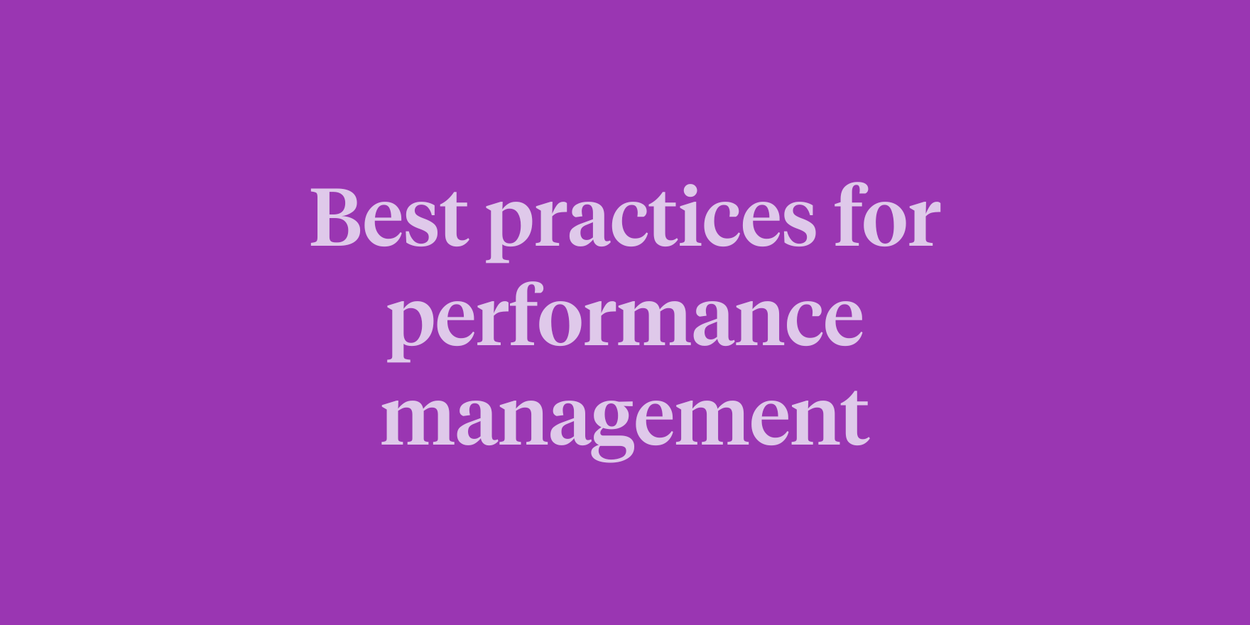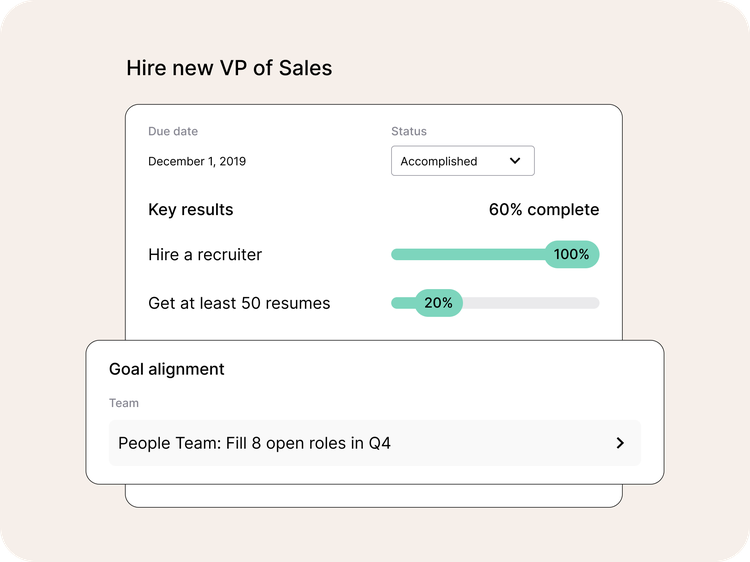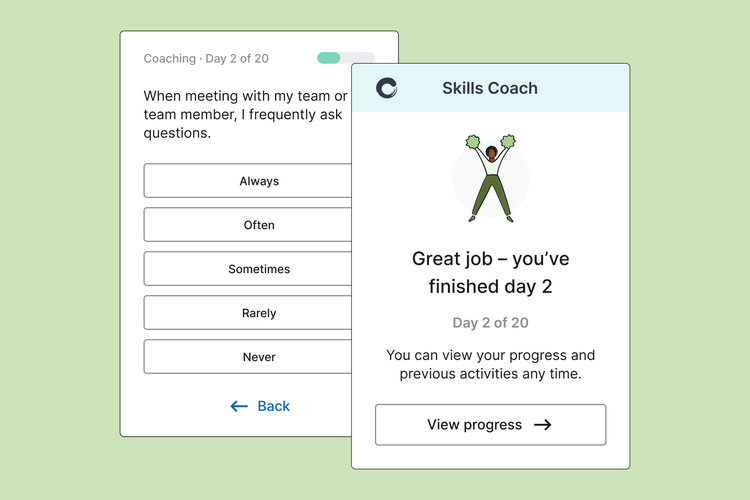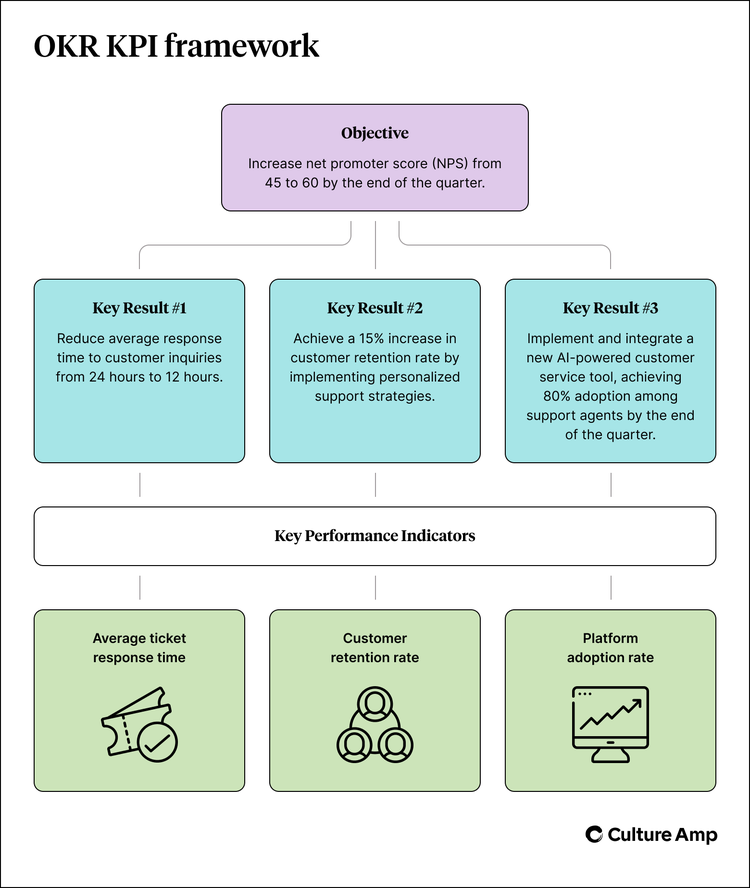
Article

Performance management is a valuable tool, but only when it’s done right. Effective performance management involves much more than setting goals and conducting annual reviews. It aligns individuals and teams with bigger organizational priorities, contributes to employee growth, and fosters a culture where people feel motivated and supported year-round.
As an HR professional or manager, you can transform organizational performance management into a driver of engagement and success. In this blog, we’ll share performance management best practices and actionable strategies to help you enhance talent development and employee engagement. Whether you’re refining existing processes or implementing new ones, these insights will support a culture of growth and accountability.
The performance management cycle consists of five unique stages: planning, monitoring, developing, reviewing and rating, and rewarding.
Here’s a closer look at what happens during each phase and the key processes involved:
Together, these stages provide employees with the guidance, support, and recognition they need to perform at the highest level.
Next, let's explore the strategic value of performance management and its role in driving business success.
Performance management connects the work of individuals and teams with the company’s overall goals, ensuring everyone focuses on the same priorities for maximum impact. By aligning individual and team objectives with broader company goals, businesses can track progress more effectively as they move toward strategic objectives. This alignment also helps employees understand how their roles contribute to overall business success, fostering a sense of purpose and ownership. Overall, this structured approach enhances organizational efficiency, drives accountability, and ensures business priorities are consistently met.
Performance management promotes regular feedback, prioritizes clear goal-setting, encourages ongoing communication, and tracks goal progress, all so businesses can create an environment where employees are motivated, aligned, and empowered to achieve their best work. It also enables managers to leverage their team's strengths while addressing areas for improvement, which ultimately helps to build stronger, more cohesive teams. Together, this fosters a high-performance culture that supports employees in reaching their full potential.
Focusing on development increases employee engagement and retention by prioritizing employee growth. When employees feel valued and see clear opportunities for internal advancement, they are more likely to remain engaged and loyal to a company. Promotions and raises aren’t the only ways to keep employees satisfied – investing in their skill development, addressing areas for improvement, and supporting their learning journey are equally important for fostering long-term engagement. This focus on development not only enhances job satisfaction but also reduces turnover, cultivating a more stable and motivated workforce.
→ Looking to predict attrition and reduce employee turnover? Download our complete guide to employee retention and turnover for practical strategies to keep your top talent around longer.
Organizational performance management delivers valuable insights into employee performance, enabling HR and leadership teams to make informed, data-driven decisions on what actions to take. These valuable performance metrics can guide strategic choices on promotions, compensation, resource allocation, training, and more. They can also help base such decisions on objective metrics, fostering fairness and transparency within the organization.
Adopting the right performance management strategies is crucial for HR leaders and managers aiming to maximize their team's capabilities. These performance management best practices promote fairness, engagement, and alignment with business goals while boosting employee productivity and enhancing job satisfaction.
Clearly defined goals are the foundation of an effective performance management strategy. When individual and team goals support broader organizational objectives, employees understand how their work contributes to the company’s success. This alignment fosters a sense of purpose, drives accountability, boosts motivation, and ensures measurable progress toward business priorities.

Feedback is most effective when it’s timely, actionable, and ongoing. If delivered too late, poorly, or inconsistently, its impact diminishes. To ensure employees receive meaningful feedback, you’ll want to:
Together, these processes cultivate a workplace focused not only on meeting performance expectations, but also on learning, improving, and growing.
Fair and transparent performance evaluations are critical to maintaining employee trust and motivation. Here are some best practices to establish consistency across your performance management processes:
When employees are confident that their evaluations are fair, they’re likely to feel more motivated and more committed to their growth and the organization's success.
Performance management should be a tool for growth, not just assessment. By identifying skill gaps and development opportunities, organizations can create personalized growth plans that empower employees to reach their full potential.
Other ways to drive growth? Offering ongoing training programs, promoting internal mentorship opportunities, sharing detailed career paths, and highlighting internal advancement opportunities. These initiatives help employees see clear growth opportunities within your organization, reducing the likelihood that they’ll seek advancement opportunities elsewhere.
Acknowledging both big wins and everyday contributions helps employees feel valued and appreciated by your business. While monetary rewards are an option, recognition doesn’t have to come with a price tag. Extra PTO, a well-deserved title change, lunch with leadership, handwritten thank-you notes, or a simple public shout-out can go a long way in making employees feel seen.
Leveraging a peer recognition tool, like Culture Amp Shoutouts, can also make regular appreciation a deep-rooted part of your culture. Consistently celebrating achievements fosters a positive work environment and motivates employees to keep striving for excellence.
Performance management isn’t just managers’ responsibility. It works best as a collaborative effort with the very people it impacts: your employees. When employees are actively involved in the process, they take greater ownership of their growth, stay more engaged, and feel more accountable for their success. By encouraging collaboration, you can create a culture where performance management is not something done to employees but something done with them.
Here’s how to encourage participation at every stage:
By actively involving employees, your business can make performance management a shared responsibility – rather than a top-down process.
Strong managers are the backbone of effective performance management. While HR provides the framework, managers are the ones who bring it to life. Investing in manager training ensures they have the skills to drive performance, support their teams, and foster a culture of growth.
Your training programs should cover skills like:
By equipping managers with these skills, your business prepares them to act as coaches who inspire, develop, and align their teams – ultimately driving the success of your performance management strategy.
Even the busiest managers can prioritize their development with Culture Amp’s Skills Coach tool. This microlearning solution delivers daily, bite-sized exercises designed to teach and reinforce essential leadership skills, helping managers grow and succeed without disrupting their workflow.

Don’t work harder; work smarter. Performance management tools, such as Culture Amp, streamline all of the processes discussed in this section and more. These powerful tools can simplify goal setting, 1-on-1s, giving and receiving feedback, employee development, performance reviews, and more. They save your business and managers time while bringing consistency and transparency to your performance management processes.
By leveraging the right software, organizations can help employees stay aligned, engaged, and supported throughout their growth journey. The right tools make performance management more than just a process – they turn it into a driver of success for both employees and the business.
Even the most well-designed performance management strategies can encounter obstacles when put into practice. To create a stronger and more effective process, it helps to know what roadblocks you may face on your path. Here are some of the most common performance management challenges – and practical solutions so you can tackle them head-on.
Challenge: When feedback isn’t delivered effectively, it can leave employees feeling defensive, frustrated, or insecure, ultimately hindering their development.
Solution: To create a culture where continuous feedback is normalized and seen as a tool for growth rather than criticism, try:
These strategies allow employees to view feedback as a valuable opportunity for growth and development, driving both individual and organizational success.
Challenge: When feedback is given sporadically or exclusively during annual reviews, employees are left without clear guidance throughout most of the year. This can stall employee development, decrease motivation, and even negatively impact overall performance.
Solution: Embrace continuous feedback by encouraging managers to conduct regular 1-on-1 meetings and have more frequent performance and development check-ins. Employees will appreciate the ongoing support, recognition of great work, and access to constructive feedback year-round.
Challenge: Unconscious bias can result in unfair or inconsistent performance evaluations, especially when a single manager determines an employee’s rating. Relying solely on one perspective may result in overlooked contributions, limited feedback, and less accurate assessments.
Solution: In addition to training managers on how to identify and minimize their biases, use 360-degree reviews to bring diverse perspectives into the appraisal process. Along with a manager’s evaluation, these reviews include self-assessments and peer feedback to provide well-rounded insights and more actionable feedback. You can also leverage calibration meetings to align evaluation standards across teams.
Challenge: Without clear and appropriately ambitious objectives, employees may feel lost, disengaged, and underutilized. They need a well-defined vision of success to understand how their performance will be evaluated for the review period.
Solution: Adopt a proven goal-setting framework like SMART (Specific, Measurable, Achievable, Relevant, Time-bound) goals or Objectives and Key Results (OKRs) to align individual and team goals with company priorities. These frameworks provide employees with clear key performance indicators so they know exactly what their managers expect from them.
Just remember, business priorities and needs change. Review goal progress and adjust targets regularly to ensure they are still attainable and serving your business’ best interests.
Challenge: Focusing too heavily on results without considering employee wellbeing can lead to burnout, dissatisfaction, and turnover.
Solution: Make employee wellbeing a regular topic in 1-on-1s and performance reviews, so managers can reinforce the importance of work-life balance on their teams and ensure employees aren’t overwhelmed. Encourage managers to track vacation usage and remind their teams to regularly take time off, so they can rest, relax, and return to work recharged.
How your business recognizes employees can also play a role in reducing burnout. Recognizing effort as well as outcomes can help your business foster a supportive and sustainable work environment where employees feel encouraged to take risks and learn from their failures.
Challenge: Even with clear goals, communication breakdowns can cause misunderstandings about expectations and leave employees feeling disconnected from their manager.
Solution: Ask managers to use shared agendas for 1-on-1 meetings to improve alignment and communication. Before each meeting, encourage employees to add their own talking points, ask questions, share concerns, and give and receive feedback as needed. By fostering an ongoing open dialogue, managers can clarify expectations, address challenges proactively, and strengthen their working relationships with employees.
Challenge: While many managers and employees discuss development and create individual growth plans during performance reviews, very few follow through. These conversations and plans are often quickly forgotten, overshadowed by daily tasks and shifting priorities.
Solution: Ask managers to revisit development plans in 1-on-1s at least once a month to track progress, discuss setbacks, and share feedback. If your business uses goal-setting software, consider tracking employee development goals alongside performance goals. This makes it easier to monitor progress, keeps development a priority, and ensures employees receive the support they need to grow.
Challenge: Your performance management processes are only as effective as the managers implementing them. If your managers lack the skills or confidence to lead meaningful performance discussions, your employees miss out on valuable feedback, support, and growth opportunities.
Solution: Provide ongoing training for new and existing managers on essential skills like coaching, delivering feedback, and adapting leadership styles. Equipping managers with these tools empowers them to lead performance discussions effectively and drive a strong performance management culture.
Traditional performance management methods don’t work for today’s flexible workforce. With employees working remotely, in the office, or in the field, businesses need a performance management solution that’s accessible anytime, anywhere.
Performance management software streamlines goal alignment, real-time feedback, development tracking, and more, reducing administrative work for managers and fostering continuous growth for employees. These tools also give you powerful insights into performance management at your company, allowing you to take a data-driven approach that keeps employees engaged and aligned with organizational objectives, whether they work in the office or remotely.
Here are some common questions and answers about performance management best practices:
A successful performance management framework includes five key steps: planning, monitoring, developing, reviewing, and rewarding. These stages involve essential processes such as setting goals, providing feedback, creating development plans, conducting reviews, and recognizing exceptional work.
To deliver constructive feedback effectively, focus on specific behaviors rather than personal traits. Use a balanced approach, neutral language, and clear examples of both past behaviors and desired changes. Make feedback timely, actionable, and delivered in a supportive, respectful manner to help employees remain receptive to what you have to share.
Performance management software helps:
This leads to stronger organizational alignment, increased productivity, more strategic business decisions, and better overall outcomes for your company.
OKRs are a great tool for tracking employee performance. They break down large goals into actionable key results that define success and make tracking progress more manageable. While some organizations view achieving all key results as the benchmark for success, others may consider achieving just one or two as a win – it all depends on your company culture and how ambitious your goals are.

Start by confirming that your performance processes reflect your organization's values, mission, and goals. Since every business has its own unique culture, your culture will shape your performance management processes. For example, a company that emphasizes learning from mistakes might create an environment where employees have the space to fail and grow. Tailoring your processes to your company culture and values ensures that performance management aligns with the behaviors and attitudes that drive success within your organization.
Culture Amp’s robust platform can help streamline processes at every stage of the performance management cycle. Here’s how:

Request a Culture Amp demo today to learn how your business can build happy, high-performing teams.